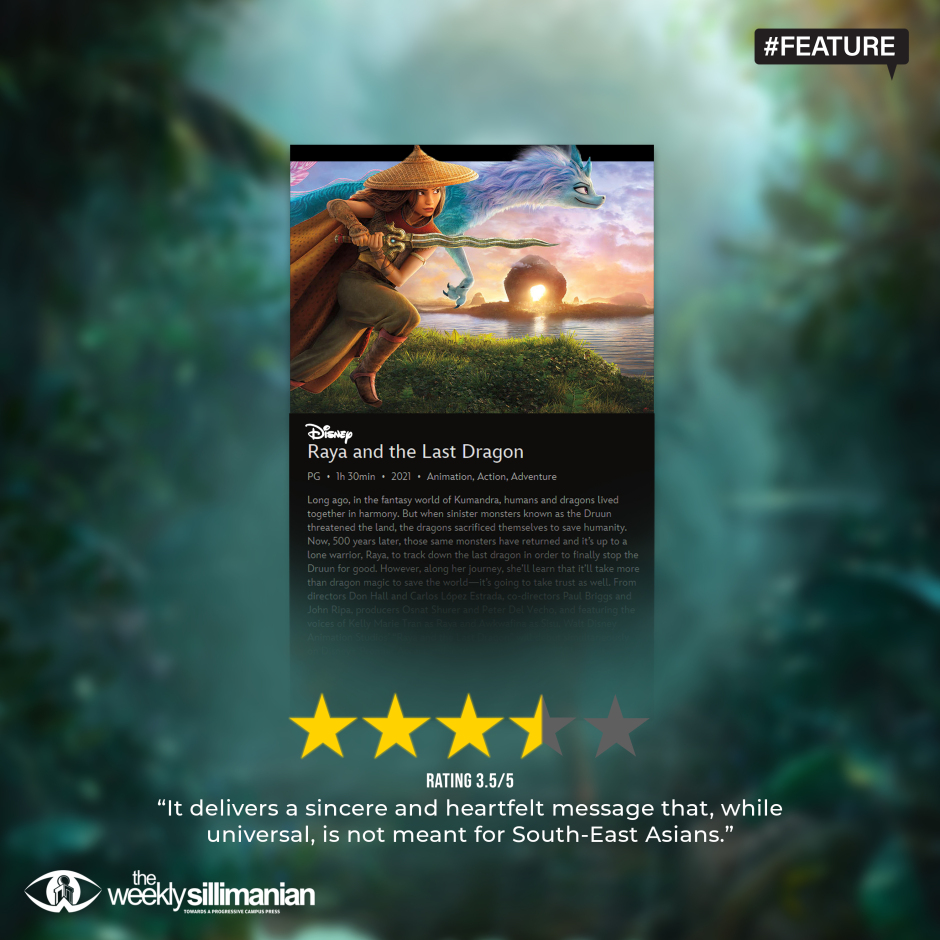By Junelie Anthony Velonta | March 16, 2021
Representation seems to be Disney’s current rule. From “princess” movies, superhero flicks, and even online series, Disney has been hiring and taking inspiration from people of various cultures and ethnicities. This action has been received well by world-wide audiences especially those from Western countries. After all, those countries claim that their strengths are from their diversity.

Like “Coco” and “Moana” before it, “Raya and the Last Dragon” takes inspiration from cultures and stories that aren’t western or white, turning them into profitable and enjoyable films. In many cases, “Raya” succeeds in this. The aesthetic of “Raya” is very representative of South-East Asia from emerald rivers, green forests, costumes that were clearly inspired by traditional clothes, to architecture that is as different as the color schemes of the five tribes.
Despite this, “Raya” also misses many marks. For a movie borrowing heavily from South-East Asians, it fails to capture and portray a sense of the “shared” South-East Asian soul. This is also reflected, perhaps not intentionally, by the soup that Raya’s father cooked for the first conference of the five tribes. To anyone versed enough in cooking, the soup contains a few token ingredients yet the way they are cooked is bland and unbalanced. It simply lacks ingredients, body. And that is also the problem at the core of “Raya.” By deconstructing the cultures of South-East Asia and re-assembling them to a framework that they don’t belong to, they create a shell without the soul, a body without a spirit, a soup lacking in flavor.
“Raya” may have the same pedigree as “Coco” and “Moana,” but it feels more like this generation’s “Mulan” more than the two prior. Why is this so? It goes beyond the martial girl and the dragon accompanying her. If “Mulan” is to be carefully analyzed, it is a film about an aspect of Chinese history yet it is not very Chinese at all. From the throw-away and haphazard use of the word honor to the dragon who is as Hollywood as it can get, “Mulan” is a movie about Chinese people but is made for Westerners. Specifically, the target audience of “Mulan” are those whose parents are Chinese yet they have not been to China nor have they experienced Chinese history and culture: second-generation immigrants. “Raya” follows in the same vein. It borrows from South-East Asia to give a story to people who have not lived here.
It is, however, unfair not to praise where “Raya” succeeds. The acting is good, albeit sometimes campy. Kelly Marie Tran’s depiction of Raya as someone who has no powers or blessings yet is dedicated though foolhardy is perhaps the strongest aspect of the film. There is a certain genuineness in Raya that is not found in the other Disney princesses. Despite the harsh criticism, the film actually delivers. It may not be as grounded to the source culture as “Coco” and “Moana” was, yet it creates a world that is fantastical yet believable.
At the end of it all, “Raya” may not have been the perfect representation of South-East Asians, but it is a good first step. It is honest. It is genuine. It delivers a sincere and heartfelt message that, while universal, is not meant for South-East Asians.


